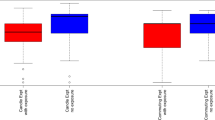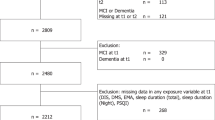Abstract
Air pollution, especially fine particulate matter (PM2.5), may impair cognitive performance1,2,3, but its short-term impact is poorly understood. We investigated the short-term association of PM2.5 with the cognitive performances of 954 white males measured as global cognitive function and Mini-Mental State Examination (MMSE) scores and further explored whether taking nonsteroidal anti-inflammatory drugs (NSAIDs) could modify their relationships. Higher short-term exposure to PM2.5 demonstrated nonlinear negative associations with cognitive function. Compared with the lowest quartile of the 28-d average PM2.5 concentration, the 2nd, 3rd and 4th quartiles were associated with 0.378, 0.376 and 0.499 unit decreases in global cognitive function score, 0.484, 0.315 and 0.414 unit decreases in MMSE score and 69, 45 and 63% greater odds of low MMSE scores (≤25), respectively. Such adverse effects were attenuated in users of NSAIDs compared to nonusers. This study elucidates the short-term impacts of air pollution on cognition and warrants further investigations on the modifying effects of NSAIDs.
This is a preview of subscription content, access via your institution
Access options
Access Nature and 54 other Nature Portfolio journals
Get Nature+, our best-value online-access subscription
$29.99 / 30 days
cancel any time
Subscribe to this journal
Receive 12 digital issues and online access to articles
$119.00 per year
only $9.92 per issue
Buy this article
- Purchase on Springer Link
- Instant access to full article PDF
Prices may be subject to local taxes which are calculated during checkout



Similar content being viewed by others
Data availability
The data that support the findings of this study are available upon reasonable request from A.A.B. The data are not publicly available due to restrictions of ethical approval requirements for this study.
Code availability
The SAS v.9.4 TS1M5 code used for the statistical analysis are available upon request from X.G.
Change history
19 May 2021
A Correction to this paper has been published: https://doi.org/10.1038/s43587-021-00075-x
References
Power, M. C., Adar, S. D., Yanosky, J. D. & Weuve, J. Exposure to air pollution as a potential contributor to cognitive function, cognitive decline, brain imaging, and dementia: a systematic review of epidemiologic research. Neurotoxicology 56, 235–253 (2016).
Griffiths, C. J. & Mudway, I. S. Air pollution and cognition. BMJ 363, k4904 (2018).
Schikowski, T. & Altug, H. The role of air pollution in cognitive impairment and decline. Neurochem. Int. 136, 104708 (2020).
World Report on Ageing and Health (World Health Organization, 2015).
Cacciottolo, M. et al. Particulate air pollutants, APOE alleles and their contributions to cognitive impairment in older women and to amyloidogenesis in experimental models. Transl. Psychiatry 7, e1022 (2017).
Ailshire, J. A. & Clarke, P. Fine particulate matter air pollution and cognitive function among U.S. older adults. J. Gerontol. B Psychol. Sci. Soc. Sci. 70, 322–328 (2015).
WHO Air Quality Guidelines for Particulate Matter, Ozone, Nitrogen dioxide, and Sulfur Dioxide: Global Update 2005: Summary of Risk Assessment (World Health Organization, 2006).
Power, M. C. et al. Traffic-related air pollution and cognitive function in a cohort of older men. Environ. Health Perspect. 119, 682–687 (2011).
Suglia, S. F., Gryparis, A., Wright, R. O., Schwartz, J. & Wright, R. J. Association of black carbon with cognition among children in a prospective birth cohort study. Am. J. Epidemiol. 167, 280–286 (2008).
Atkinson, R. W. et al. Short-term exposure to traffic-related air pollution and daily mortality in London, UK. J. Expo. Sci. Environ. Epidemiol. 26, 125–132 (2016).
Guo, B. et al. Using rush hour and daytime exposure indicators to estimate the short-term mortality effects of air pollution: a case study in the Sichuan Basin, China. Environ. Pollut. 242, 1291–1298 (2018).
Laumbach, R., Meng, Q. & Kipen, H. What can individuals do to reduce personal health risks from air pollution? J. Thorac. Dis. 7, 96–107 (2015).
Calderón-Garcidueñas, L. et al. Brain inflammation and Alzheimer’s-like pathology in individuals exposed to severe air pollution. Toxicol. Pathol. 32, 650–658 (2004).
Calderón-Garcidueñas, L. et al. DNA damage in nasal and brain tissues of canines exposed to air pollutants is associated with evidence of chronic brain inflammation and neurodegeneration. Toxicol. Pathol. 31, 524–538 (2003).
Delfino, R. J. et al. Circulating biomarkers of inflammation, antioxidant activity, and platelet activation are associated with primary combustion aerosols in subjects with coronary artery disease. Environ. Health Perspect. 116, 898–906 (2008).
Bind, M. A. et al. Air pollution and markers of coagulation, inflammation, and endothelial function: associations and epigene-environment interactions in an elderly cohort. Epidemiology 23, 332–340 (2012).
Vendemiale, G., Romano, A. D., Dagostino, M., de Matthaeis, A. & Serviddio, G. Endothelial dysfunction associated with mild cognitive impairment in elderly population. Aging Clin. Exp. Res. 25, 247–255 (2013).
De Silva, T. M. & Faraci, F. M. Microvascular dysfunction and cognitive impairment. Cell. Mol. Neurobiol. 36, 241–258 (2016).
Block, M. L., Zecca, L. & Hong, J.-S. Microglia-mediated neurotoxicity: uncovering the molecular mechanisms. Nat. Rev. Neurosci. 8, 57–69 (2007).
Jordan, F. et al. Aspirin and other non-steroidal anti-inflammatory drugs for the prevention of dementia. Cochrane Database Syst. Rev. 4, CD011459 (2020).
Veronese, N. et al. Low-dose aspirin use and cognitive function in older age: a systematic review and meta-analysis. J. Am. Geriatr. Soc. 65, 1763–1768 (2017).
Shehab, M. A. & Pope, F. D. Effects of short-term exposure to particulate matter air pollution on cognitive performance. Sci. Rep. 9, 8237 (2019).
Lo, Y. C., Lu, Y. C., Chang, Y. H., Kao, S. & Huang, H. B. Air pollution exposure and cognitive function in Taiwanese older adults: a repeated measurement study. Int. J. Environ. Res. Public Health 16, 2976 (2019).
Zanobetti, A., Dominici, F., Wang, Y. & Schwartz, J. D. A national case-crossover analysis of the short-term effect of PM2.5 on hospitalizations and mortality in subjects with diabetes and neurological disorders. Environ. Health 13, 38 (2014).
Lee, H. et al. Short-term air pollution exposure aggravates Parkinson’s disease in a population-based cohort. Sci. Rep. 7, 44741 (2017).
Masri, S., Kang, C.-M. & Koutrakis, P. Composition and sources of fine and coarse particles collected during 2002-2010 in Boston, MA. J. Air Waste Manag. Assoc. 65, 287–297 (2015).
Laden, F., Neas, L. M., Dockery, D. W. & Schwartz, J. Association of fine particulate matter from different sources with daily mortality in six U.S. cities. Environ. Health Perspect. 108, 941–947 (2000).
McNeil, J. J. et al. Effect of aspirin on disability-free survival in the healthy elderly. N. Engl. J. Med. 379, 1499–1508 (2018).
Berk, M. et al. Aspirin: a review of its neurobiological properties and therapeutic potential for mental illness. BMC Med. 11, 74 (2013).
Fond, G. et al. Effectiveness and tolerance of anti-inflammatory drugs’ add-on therapy in major mental disorders: a systematic qualitative review. Acta Psychiatr. Scand. 129, 163–179 (2014).
Tegeler, C. et al. The inflammatory markers CRP, IL-6, and IL-10 are associated with cognitive function: data from the Berlin Aging Study II. Neurobiol. Aging 38, 112–117 (2016).
Wellenius, G. A. et al. Ambient fine particulate matter alters cerebral hemodynamics in the elderly. Stroke 44, 1532–1536 (2013).
Novak, V. Cognition and hemodynamics. Curr. Cardiovasc. Risk Rep. 6, 380–396 (2012).
Xu, L. et al. Effect of enoxaparin and aspirin on hemodynamic disturbances after global cerebral ischemia in rats. Resuscitation 81, 1709–1713 (2010).
Sarnat, J. A., Brown, K. W., Schwartz, J., Coull, B. A. & Koutrakis, P. Ambient gas concentrations and personal particulate matter exposures: implications for studying the health effects of particles. Epidemiology 16, 385–395 (2005).
Zeger, S. L. et al. Exposure measurement error in time-series studies of air pollution: concepts and consequences. Environ. Health Perspect. 108, 419–426 (2000).
Gao, X. et al. Nonsteroidal antiinflammatory drugs modify the effect of short-term air pollution on lung function. Am. J. Respir. Crit. Care Med. 201, 374–378 (2020).
Bell, B., Rose, C. L. & Damon, A. The Normative Aging Study: an interdisciplinary and longitudinal study of health and aging. Int. J. Aging Hum. Dev. 3, 5–17 (1972).
Weisskopf, M. G. et al. Cumulative lead exposure and prospective change in cognition among elderly men: the VA Normative Aging Study. Am. J. Epidemiol. 160, 1184–1193 (2004).
Colicino, E. et al. Telomere length, long-term black carbon exposure, and cognitive function in a cohort of older men: the VA Normative Aging Study. Environ. Health Perspect. 125, 76–81 (2017).
Gao, X. et al. Impacts of air pollution, temperature, and relative humidity on leukocyte distribution: an epigenetic perspective. Environ. Int. 126, 395–405 (2019).
Pateraki, S., Asimakopoulos, D. N., Flocas, H. A., Maggos, T. & Vasilakos, C. The role of meteorology on different sized aerosol fractions (PM10, PM2.5, PM2.5–10). Sci. Total Environ. 419, 124–135 (2012).
Tian, X., Fang, Z. & Liu, W. Decreased humidity improves cognitive performance at extreme high indoor temperature. Indoor Air https://doi.org/10.1111/ina.12755 (2020).
Desquilbet, L. & Mariotti, F. Dose–response analyses using restricted cubic spline functions in public health research. Stat. Med. 29, 1037–1057 (2010).
Seaman, S. R. & White, I. R. Review of inverse probability weighting for dealing with missing data. Stat. Methods Med. Res. 22, 278–295 (2013).
Acknowledgements
This work was supported by the National Institute of Environmental Health Sciences (grant nos. P30ES009089, R01ES021733, R01ES025225, R01ES015172 and R01ES027747). The Veterans Affairs Normative Aging Study is supported by the Cooperative Studies Program/Epidemiology Research and Information Center of the U.S. Department of Veterans Affairs and is a component of the Massachusetts Veterans Epidemiology Research and Information Center. A.S. was supported by a Senior Research Career Scientist award from the Clinical Science R&D Service of the U.S. Department of Veterans Affairs.
Author information
Authors and Affiliations
Contributions
X.G. and A.A.B. developed the research question. X.G. carried out the main data analyses, interpreted the data and drafted the manuscript. J.S. and A.A.B. conducted the NAS study and contributed to all aspects of this work. P.V. and A.S. provided the data of the NAS study. B.C., X.L. and L.H. contributed to the statistical modeling. All authors reviewed the manuscript drafts, critically revised the manuscript and approved the final manuscript.
Corresponding author
Ethics declarations
Competing interests
The authors declare no competing interests.
Additional information
Peer review information Nature Aging thanks Howard Fink, Francis Pope, Joanne Ryan and Deborah Slechta for their contribution to the peer review of this work.
Publisher’s note Springer Nature remains neutral with regard to jurisdictional claims in published maps and institutional affiliations.
Extended data
Extended Data Fig. 1 Best-fitting models for the relationships of PM2.5 levels with GCF score, MMSE score, and odds of low MMSE score in the exposure window of 21 days.
Analyses were performed based on the data of 2551 medical visits from 954 participants. Solid line: point estimates; dash line: confidence intervals; dot: knots; green line: reference line.
Extended Data Fig. 2 Best-fitting models for the relationships of PM2.5 levels with GCF score, MMSE score, and odds of low MMSE score in the exposure window of 21 days, by NSAID use.
Analyses were performed based on the data of 2551 medical visits from 954 participants. Solid line: point estimates; dash line: confidence intervals; dot: knots; green line: reference line.
Supplementary information
Supplementary Information
Supplementary Tables 1–10, Figs. 1–4 and STROBE statement.
Rights and permissions
About this article
Cite this article
Gao, X., Coull, B., Lin, X. et al. Short-term air pollution, cognitive performance and nonsteroidal anti-inflammatory drug use in the Veterans Affairs Normative Aging Study. Nat Aging 1, 430–437 (2021). https://doi.org/10.1038/s43587-021-00060-4
Received:
Accepted:
Published:
Issue Date:
DOI: https://doi.org/10.1038/s43587-021-00060-4
This article is cited by
-
Same stimuli, different responses: a pilot study assessing air pollution visibility impacts on emotional well-being in a controlled environment
Frontiers of Environmental Science & Engineering (2023)
-
Progress in Mechanisms, Pathways and Cohort Studies About the Effects of PM2.5 Exposure on the Central Nervous System
Reviews of Environmental Contamination and Toxicology (2023)
-
Lower test scores from wildfire smoke exposure
Nature Sustainability (2022)
-
The impact of the climate crisis on brain health
Nature Aging (2021)



